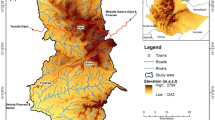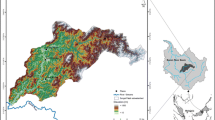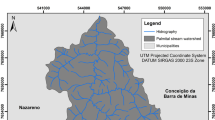Abstract
Soil loss poses a significant threat to the long-term sustainability of hydrological systems, the environment, and agriculture. In this regard, efficient soil management relies on accurate quantification of soil loss. To this end, the Organization for Economic Cooperation and Development (OECD) standard of soil erosion, developed for agricultural areas, has been applied in many countries, including South Korea. Due to the lack of standard methods for assessing soil erosion in South Korea, the OECD standard has been applied to non-agricultural regions of Korea despite the possibility that local soil erosion characteristics may differ from those in agricultural areas. Such an approach might give erroneous information on soil loss to policy and decision makers. This study estimated soil loss for eight different land cover-types in Korea using the universal soil loss equation, and compared the results with those from the unmodified OECD soil erosion standard. Estimated soil loss differed considerably among land-cover types. The results have implications on the limitations in applying the OECD soil erosion standard to soil management in Korea. Thus, this study suggests a modified soil erosion standard for efficient soil management.









Similar content being viewed by others
References
Albaradeyia I, Hani A, Shahrour I (2011) WEPP and ANN models for simulating soil loss and runoff in a semi-arid Mediterranean region. Environ Monit Assess 180(1–4):537–556. doi:10.1007/s10661-010-1804-x
Bagarello V, Stefano CD, Ferro V, Giordano G, Invino M, Pampalone V (2012) Estimating the USLE soil erodibility factor in Sicily, South Italy. Appl Eng Agric 28(2):199–206
Beasley DB, Huggins LF, Monke EJ (1980) ANSWERS: a model for watershed planning. Trans ASAE 23:938–944
Feng X, Wang Y, Chen L, Fu B, Bai G (2010) Modelling soil erosion and its response to land-use change in hilly catchments of the Chinese Loess Plateau. Geomorphology 118:239–248
Jeong DH, Kim H, Lee YJ, Hong S, Yoon J, Choi H, Cho HL (2012) A study on selection and measure of the apprehensive areas of soil loss in the So-ok stream watershed. J Environ Impact Assess 21:617–629
John FB, Andy JP, Claire M, Simon DT, Rob WS, Jerry EW (2011) Land use, soil erosion, and sediment yield at Pinto Lake, California: comparison of a simplified USLE model with the lake sediment record. J Paleolimnol 45:199–212. doi:10.1007/s10933-010-9491-8
Joo JH, Yang JE, Jung YS (2004) Watershed management and water quality in the doam-dam (focuses on agricultural land soil loss). In: Chuncheon Global Water Forum 2004 Organizing Committee, Chuncheon, Republic of Korea, pp 355–390
Jung KH, Kim WT, Hur SO, Ha SK, Jung PK, Jung YS (2004) USLE/RUSLE factors for national scale soil loss estimation based on the digital detailed soil map. Korean J Soil Sci Fertil 37:199–206
Kang H, Kim KS, Park YS, Kim N, Ok YS, Kim J, Choi YH, Lim KJ (2009) Development and application of SATEEC L module for slope length adjustment based on topography change. Korean J Environ Agric 28(2):113–124
Kim J, Park YS, Yoo D, Kim NW, Engel BA, Kim SJ, Kim KS, Lim KJ (2009) Development of a SWAT patch for better estimation of sediment yield in steep sloping watersheds. J Am Water Resour Assoc 45(4):963–972
Kim MK, Hur SO, Kwon SI, Jung GB, Sonn YK, Ha SK, Lee DB (2010) Prediction of soil erosion from agricultural uplands under precipitation change scenarios. Korean J Soil Sci Fertil 43:789–792
Kinnell PIA (2010) Event soil loss, runoff and the universal soil loss equation family of models: a review. J Hydrol 385(1):384–397
KMOE (2010) Research on progressive methodology for economic value evaluation of soil and groundwater. Ministry of Environment, Gwachoen
KMOE (2012a) The topsoil preliminary investigation guidance (TPIG). Ministry of Environment, Gwachoen
KMOE (2012b) Act 6.2 of the Soil Environmental Protection Law (SEPL). Ministry of Environment, Sejong
Knisel WG (1980) CREAMS: a field scale model for chemicals, runoff, and erosion from agricultural management systems. US Department of Agriculture Research Service Report NO. 26, USDA, Washington, DC
Kum D, Ryu J, Kang H, Jang C, Shin MH, Shin DS, Choi J, Lim KJ (2011) Comparison of annual soil loss using USLE and hourly soil erosion evaluation system. Korean J Soil Sci Fert 44:991–997
Lee S (2004) Soil erosion assessment and its verification using the universal soil loss equation and geographic information system: a case study at Boun, Korea. Environ Geol 45(4):457–465
Lee G, Yu W, Jung K (2013) Catchment-scale soil erosion and sediment yield simulation using a spatially distributed erosion model. Environ Earth Sci 70(1):33–47
Li Z, Liu WZ, Zhang XC, Zheng FL (2011) Assessing the site-specific impacts of climate change on hydrology, soil erosion and crop yields in the Loess Plateau of China. Clim Change 105:223–242. doi:10.1007/s10584-010-9875-9
Lu D, Li G, Valladares GS, Batistella M (2004) Mapping soil erosion risk in Rondonia, Brazilian Amazonia: using RUSLE, remote sensing and GIS. Land Degrad Dev 15(5):499–512
Moore I, Burch G (1986a) Physical basis of the length-slope factor in the universal soil loss equation. Soil Sci Soc Am J 50:1294–1298
Moore I, Burch G (1986b) Modeling erosion and deposition: topographic effects. Trans ASABE 29:1624–1640
Morgan RPC, Quinton JN, Rickson RJ (1990) Structure of the soil erosion prediction model for the European community. In: Proceedings of international symposium on water erosion, sedimentation and resource conservation, Dehradun
Nearing MA, Forster GR, Lane LJ (1989) A process-based soil erosion model for USDA water erosion prediction project. Trans ASAE 32:1587–1593
Organization for Economic Cooperation and Development (OECD) (2008) Environmental performance of agriculture in OECD countries since 1990. OECD. doi: 10.1787/9789264040854-en
Organization for Economic Cooperation and Development (OECD) (2013) OECD compendium of agri-environmental indicators. OECD. doi: 10.1787/9789264186217-en
Park JH, Woo HS, Pyun CK, Kim KK (2000) A study of distribution of rainfall erosivity in USLE/RUSLE for estimation of soil loss. J Korea Water Res Assoc 33:603–610
Park S, Oh C, Jeon S, Jung H, Choi C (2011) Soil erosion risk in Korean watersheds, assessed using the revised universal soil loss equation. J Hydrol 399(3):263–273
Prasannakumar V, Vijith H, Abinod S, Geetha N (2012) Estimation of soil erosion risk within a small mountainous sub-watershed in Kerala, India, using revised universal soil loss equation (RUSLE) and geo-information technology. Geosci Front 3(2):209–215
Renard KG, Foster GR, Weesies GA, McCool DK, Yode DC (1997) Predicting soil erosion by water: a guide to conservation planning with the revised universal soil loss equation, RUSLE. Agriculture Handbook, No. 703, USDA, Washington, DC
Shengpan L, Changwei J, Neil AC, Vincent C, Nathan JM, Jiaping W (2013) Evaluating DEM source and resolution uncertainties in the Soil and Water Assessment Tool. Stoch Environ Res Risk Assess 27:209–221. doi:10.1007/s00477-012-0590-0
Shi ZH, Cai CF, Ding SW, Wang TW, Chow TL (2004) Soil conservation planning at the small watershed level using RUSLE with GIS: a case study in the Three Gorge area of China. Catena 55(1):33–48
Shin KJ (1999) The soil loss analysis using GSIS in watershed, Dissertation, Kangwon National University, South Korea
Shin Y, Choi J, Lim KJ, Shim H, Lyou C, Yang JE, Yoo KY (2005) Pollutant load characteristics from a small mountainous agricultural watershed in the North Han River Basin. J Korean Soc Agric Eng 47:83–92
Singh A, Imtiyaz M, Isaac RK, Denis DM (2014) Assessing the performance and uncertainty analysis of the SWAT and RBNN models for simulation of sediment yield in the Nagwa watershed, India. Hydrol Sci J 59(2):351–364
Terranova O, Antronico R, Coscarelli R, Iaquinta P (2009) Soil erosion risk scenarios in the Mediterranean environment using RUSLE and GIS: an application model for Calabria (southern Italy). Geomorphology 112(2009):228–245
Tibebe D, Bewket W (2011) Surface runoff and soil erosion estimation using the SWAT model in the Keleta watershed, Ethiopia. Land Degrad Dev 22(6):551–564
Toy TJ, Foster GR (1998) Guidelines for the use of the revised universal soil loss equation (RUSLE), version 1.06 on Mined Lands, Construction Sites and Reclaimed Lands. In: Joe RG (ed) The Office of Technology Transfer. Western Regional Coordinating Center Office of Surface Mining, Denver
Wischmeier WH, Smith DD (1965) Predicting rainfall erosion losses from cropland east of the Rocky Mountains, US, Agriculture Handbook, No. 282, US Department of Agriculture Research Service, Washington, DC
Wischmeier WH, Smith DD (1978) Predicting rainfall erosion losses: a guide to conservation planning. The USDA Agricultural Handbook No. 537. USDA, Washington, DC, pp 1–58
Yang D, Kanae S, Oki T, Koike T, Musiake K (2003) Global potential soil erosion with reference to land cover and climate changes. Hydrol Process 17:2913–2928
Yoo SH (2000) Soil dictionary. Seoul National University Press, Seoul
Zhang P, Liu R, Bao Y, Wang J, Yu W, Shen Z (2014) Uncertainty of SWAT model at different DEM resolutions in a large mountainous watershed. Water Res 53:132–144
Zhenlan J, Shiliang S, Changwei J, Shengpan L, Xufeng F, Jiaping W (2012) Spatiotemporal dynamics of soil erosion risk for Anji County, China. Stoch Environ Res Risk Assess 26:751–763. doi:10.1007/s00477-012-0590-0
Acknowledgments
This research was supported by the Geo-Advanced Innovative Action (GAIA) Project (No. RE201402074, Surface Soil Resources Inventory & Integration: SSORII Research Group) in the Republic of Korea.
Author information
Authors and Affiliations
Corresponding author
Rights and permissions
About this article
Cite this article
Jang, C., Shin, Y., Kum, D. et al. Assessment of soil loss in South Korea based on land-cover type. Stoch Environ Res Risk Assess 29, 2127–2141 (2015). https://doi.org/10.1007/s00477-015-1027-3
Published:
Issue Date:
DOI: https://doi.org/10.1007/s00477-015-1027-3




